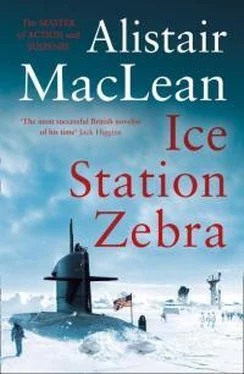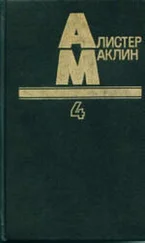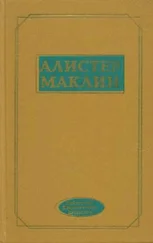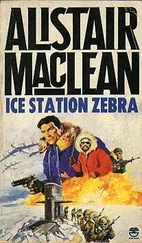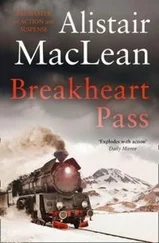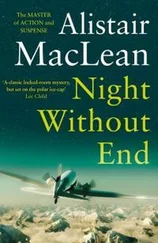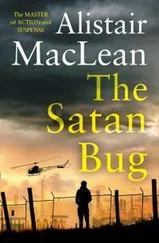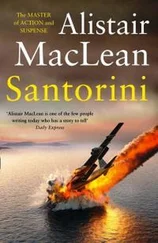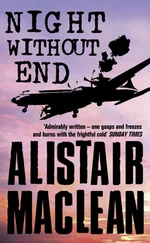‘He miscalculated,’ I said mildly. ‘Come along.’
They were waiting for us in the wardroom as I’d arranged, eleven of them in all – Rawlings, Zabrinski, Captain Folsom, Dr Jolly, the two Harrington twins, who were now just barely well enough to be out of bed, Naseby, Hewson, Hassard, Kinnaird and Jeremy. Most of them were seated round the wardroom table except for Rawlings, who opened the door for us, and Zabrinski, his foot still in the cast, who was sitting in a chair in one corner of the room, studying an issue of the Dolphin Daze, the submarine’s own mimeographed newspaper. Some of them made to get to their feet as we came in but Swanson waved them down. They sat, silently, all except Dr Jolly who boomed out a cheerful: ‘Good morning, Captain. Well, well, this is an intriguing summons. Most intriguing. What is it you want to see us about, Captain?’
I cleared my throat. ‘You must forgive a small deception. It is I who wants to see you, not the captain.’
‘You?’ Jolly pursed his lips and looked at me speculatively. ‘I don’t get it, old boy. Why you?’
‘I have been guilty of another small deception. I am not, as I gave you to understand, attached to the Ministry of Supply. I am an agent of the British Government. An officer of M.I.6, counterespionage.’
Well, I got my reaction, all right. They just sat there, mouths wide open like newly-landed fish, staring at me. It was Jolly, always a fast adjuster, who recovered first.
‘Counter-espionage, by jove! Counter-espionage! Spies and cloaks and daggers and beautiful blondes tucked away in the wardrobes – or wardroom, should I say. But why – but why are you here? What do you – well, what can you want to see us about, Dr Carpenter?’
‘A small matter of murder,’ I said.
‘Murder!’ Captain Folsom spoke for the first time since coming aboard ship, the voice issuing from that savagely burnt face no more than a strangled croak. ‘Murder?’
‘Two of the men lying up there now in the Drift Station lab were dead before the fire. They had been shot through the head. A third had been knifed. I would call that murder, wouldn’t you?’
Jolly groped for the table and lowered himself shakily into his seat. The rest of them looked as if they were very glad that they were already sitting down.
‘It seems so superfluous to add,’ I said, adding it all the same, ‘that the murderer is in this room now.’
You wouldn’t have thought it, not to look at them. You could see at a glance that none of those high-minded citizens could possibly be a killer. They were as innocent as life’s young morning, the whole lot of them, pure and white as the driven snow.
It would be an understatement to say that I had the attention of the company. Maybe had I been a two-headed visitor from outer space, or had been about to announce the result of a multi-million pound sweepstake in which they held the only tickets, or was holding straws for them to pick to decide who should go before the firing squad – maybe then they might have given me an even more exclusive degree of concentration. But I doubt it. It wouldn’t have been possible.
‘If you’ll bear with me,’ I began, ‘first of all I’d like to give you a little lecture in camera optics – and don’t ask me what the hell that has to do with murder, it’s got everything to do with it, as you’ll find out soon enough.
‘Film emulsion and lens quality being equal, the clarity of detail in any photograph depends upon the focal length of the lens – that is, the distance between the lens and the film. As recently as fifteen years ago the maximum focal length of any camera outside an observatory was about fifty inches. Those were used in reconnaissance planes in the later stages of the Second World War. A small suitcase lying on the ground would show up on a photograph taken from a height of ten miles, which was pretty good for those days.
‘But the American Army and Air Force wanted bigger and better aerial cameras, and the only way this could be done was by increasing the focal length of the lens. There was obviously a superficial limit to this length because the Americans wanted this camera to fit into a plane – or an orbiting satellite – and if you wanted a camera with a focal length of, say, 250 inches, it was obviously going to be quite impossible to install a twenty-foot camera pointing vertically downwards in a plane or small statellite. But scientists came up with a new type of camera using the folded lens principle, where the light, instead of coming down a long straight barrel, is bounced round a series of angled mirrored corners, which permits the focal length to be increased greatly without having to enlarge the camera itself. By 1950 they’d developed a hundred-inch focal length lens. It was quite an improvement on the World War II cameras which could barely pick up a suitcase at ten miles – this one could pick up a cigarette packet at ten miles. Then, ten years later, came what they called the Perkin-Elmer Roti satellite missile tracker, with a focal length of five hundred inches – equivalent to a barrel type camera forty feet long: this one could pick up a cube of sugar at ten miles.’
I looked inquiringly around the audience for signs of inattention. There were no signs of inattention. No lecturer ever had a keener audience than I had there.
‘Three years later,’ I went on, ‘another American firm had developed this missile tracker into a fantastic camera that could be mounted in even a small-size satellite. Three years’ non-stop work to create this camera – but they reckoned it worth it. We don’t know the focal length, it’s never been revealed: we do know that, given the right atmospheric conditions, a white saucer on a dark surface will show up clearly from 300 miles up in space. This on a relatively tiny negative capable of almost infinite enlargement – for the scientists have also come up with a completely new film emulsion, still super-secret and a hundred times as sensitive as the finest films available on the commercial market today.
‘This was to be fitted to the two-ton satellite the Americans called Samos III – Samos for Satellite and Missile Observation System. It never was. This, the only camera of its kind in the world, vanished, hi-jacked in broad daylight and, as we later learned, dismantled, flown from New York to Havana by a Polish jet-liner which had cleared for Miami and so avoided customs inspection.
‘Four months ago this camera was launched in a Soviet satellite on a polar orbit, crossing the American Middle West seven times a day. Those satellites can stay up indefinitely, but in just three days, with perfect weather conditions, the Soviets had all the pictures they ever wanted – pictures of every American missile launching base west of the Mississippi. Every time this camera took a picture of a small section of the United States another smaller camera in the satellite, pointing vertically upwards, took a fix on the stars. Then it was only a matter of checking map co-ordinates and they could have a Soviet inter-continental ballistic missile ranged in on every launching-pad in America. But first they had to have the pictures. Radio transmission is no good, there’s far too much quality and detail lost in the process – and you must remember this was a relatively tiny negative in the first place. So they had to have the actual films. There are two ways of doing this – bring the satellite back to earth or have it eject a capsule with the films. The Americans, with their Discoverer tests, have perfected the art of using planes to snatch falling capsules from the sky. The Russians haven’t, although we do know they have a technique for ejecting capsules should a satellite run amok. So they had to bring the satellite down. They planned to bring it down some two hundred miles east of the Caspian. But something went wrong. Precisely what we don’t know, but our experts say that it could only have been due to the fact that the retro-rockets on one side of the capsule failed to fire when given the radio signal to do so. You are beginning to understand, gentlemen?’
Читать дальше
Конец ознакомительного отрывка
Купить книгу
